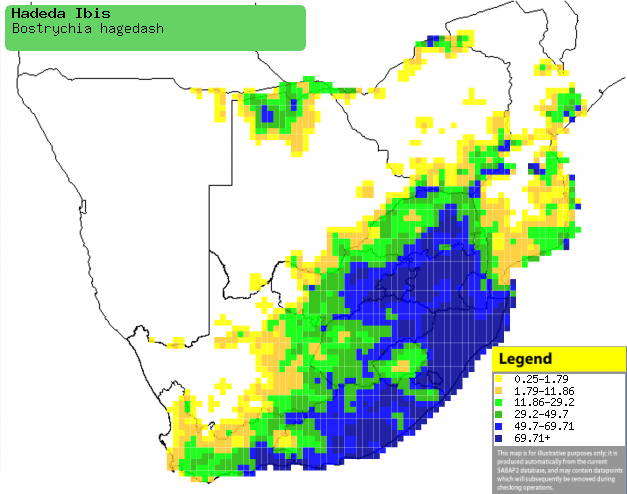Bostrychia hagedash
(Hadeda
ibis)
Hadeda [Afrikaans]; Ing'ang'ane [Xhosa]; iNkankane
[Zulu]; Ngoromuduva [Kwangali]; Lengaangane, Lengangane [South Sotho];
Lingangane [Swazi]; Xikohlwa hi jambo [Tsonga]; Hadada-ibis [Dutch]; Ibis
hagedash [French]; Hagedasch-Ibis [German]; Singanga [Portuguese]
Life
> Eukaryotes >
Opisthokonta
> Metazoa (animals) >
Bilateria >
Deuterostomia > Chordata >
Craniata > Vertebrata (vertebrates) > Gnathostomata (jawed
vertebrates) > Teleostomi (teleost fish) > Osteichthyes (bony fish) > Class:
Sarcopterygii (lobe-finned
fish) > Stegocephalia (terrestrial
vertebrates) > Tetrapoda
(four-legged vertebrates) > Reptiliomorpha > Amniota >
Reptilia (reptiles) >
Romeriida > Diapsida > Archosauromorpha > Archosauria >
Dinosauria
(dinosaurs) > Saurischia > Theropoda (bipedal predatory dinosaurs) >
Coelurosauria > Maniraptora > Aves
(birds) > Order: Ciconiiformes
> Family: Threskiornithidae
Distribution and habitat
Occurs across Africa south of the Sahel; in southern
Africa, it is common in northern Botswana, the Caprivi Strip (Namibia), northern and southern Zimbabwe, Mozambique and much
of South Africa, excluding parts of the arid Karoo. It generally prefers open
grassland with well-wooded valleys and patches of dense woodland, also occurring
in clearings in
forest, marshes with short grass, moist grassland, irrigated croplands with lucerne and clover (Medicago),
playing fields, pastures, airfields and lawns in suburbia.
|
 |
|
Distribution of Hadeda ibis in southern Africa,
based on statistical smoothing of the records from first SA Bird Atlas
Project (©
Animal Demography unit, University of
Cape Town; smoothing by Birgit Erni and Francesca Little). Colours range
from dark blue (most common) through to yellow (least common).
See here for the latest distribution
from the SABAP2. |
Predators and parasites
- Predators
- of adults
- of chicks and eggs
Movements and migrations
Mainly sedentary, although it may make
movements in response to rainfall, and juveniles tend to disperse
from their parents territory after becoming independent.
Food
It mainly eats invertebrates, doing most of its foraging on
moist ground, probing for prey or taking them from the soil surface. The following food items have been recorded
in its diet:
- Invertebrates
- insects
- earthworms
- molluscs
- Vertebrates
- Other
- dog food taken from bowls
Breeding
- Monogamous, solitary nester, probably with a life-long pair bond.
- The nest is probably built solely by the female in less than two weeks,
rarely up to a month, consisting of a platform of sticks with a central bowl
lined with grass, lichen, weeds, leaves and other debris. It is typically
placed in the fork of a horizontal branch, or occasionally on another
structure such a cliff, dam wall, telephone pole or pergola.
- Egg-laying season is from June-March, peaking from September-November.
- It lays 1-5 eggs, which are incubated by both sexes for about 25-28 days,
in shifts up to three hours.
- The chicks are fed by both parents by regurgitation and brooded
constantly for the first week of their life, less frequently thereafter. The chick
leaves the nest at about 33-40 days old, becoming fully independent at
roughly 60 days old.
Threats
Not threatened, in fact its range and population have
greatly decreased in the past 75 years, largely due to an increase in the
availability of nest sites and food from habitat modification by humans.
References
-
Hockey PAR, Dean WRJ and Ryan PG 2005. Roberts
- Birds of southern Africa, VIIth ed. The Trustees of the John Voelcker
Bird Book Fund, Cape Town.
|
